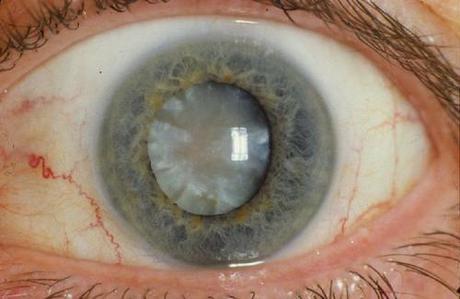Yesterday, a friend had cataract surgery — something that happens to many people as we grow old.
In fact, by age 80, more than half of all Americans either have a cataract (clouded lens) or have had cataract surgery although people can have an age-related cataract in their 40s and 50s. (National Institute of Health)

Cataracts can also happen after an eye injury, as a result of eye disease, after you use certain medicines, or as a result of health problems such as diabetes.
Cataracts develop when protein in the lens of our eyes builds up and prevents light from getting through. According to the Centers for Disease Control and Prevention, cataracts are the leading cause of blindness worldwide and the leading cause of vision loss in the U.S.
Currently, the only treatment available for cataracts is surgically removing the clouded lens from the eye and replacing it with an artificial lens. But scientists in California have discovered that a naturally-occurring steroid, lanosterol, is able to melt away cataracts and prevent them from returning when administered to patients via eye drops. If approved for human use, the compound would be available as a non-invasive treatment for individuals with moderate forms of cataracts.
Dana Dovey writes for Medical Daily, July 23, 2015, that scientists first became aware of lanosterol cataract-blocking abilities by observing two children in China who had a hereditary form of the condition. Upon closer examination, it became clear that the children shared a mutation that blocked the production of the steroid lanosterol, Science Alert reported. Their parents lacked this mutation and as a result never went on to develop cataracts. From this observation, the team proposed that the steroid must play a role in the formation of cataracts.
In a series of experiments, the team tested lanosterol on donated human lenses and live rabbits and dogs. Results repeatedly showed that lanosterol was able to significantly shrink cataract size. (See Zhao L, Chen X, Zhu J., “Lanosterol reverses protein aggregation in cataracts,” Nature, 2015.)
Although it’s not entirely clear how lanosterol is working, the researchers believe that the steroid prevents the proteins from building up. According to Tech Times, if the drops prove to also work on humans, they could offer a non-invasive treatment for individuals with mild to moderate cataracts and serve as a way to prevent the condition from ever returning. While cataract surgery is relatively easy and safe, the drops would serve as an easier alternative for the 50 million Americans estimated to be afflicted by the condition by the year 2050.
Despite not yet being tested on humans, the study is already causing excitement. Jonathan King, a molecular biologist from the Massachusetts Institute of Technology, said the study is the strongest of its kind that he’s seen in decades: “They discovered the phenomena and then followed with all of the experiments that you should do — that’s as biologically relevant as you can get.”
Things that increase your risk for cataracts include (WebMD):
- Age: Getting older is a major risk factor for cataracts.
- Family history (genetics): People with a family history of cataracts are more likely to have cataracts. People with certain genetic disorders may also have an increased risk for cataracts.
- Some chronic diseases increase the risk for cataracts, a leading candidate is diabetes. People with diabetes are at increased risk for cataracts due to damage to the lens of the eye from persistent high blood sugar (glucose) levels.
- Glaucoma: Surgery to treat glaucoma may raise the risk of cataracts.
- Other things that may increase your risk include:
- Smoking: People who smoke are more likely to develop cataracts because smoking may damage the lens of the eye by leading to the formation of chemicals called free radicals. High levels of free radicals can damage cells, including those in the lens of the eye.
- Infection during pregnancy: If a woman has certain infections during pregnancy, such as rubella or chickenpox, the baby may develop a cataract before birth.
- Ultraviolet (UV) light exposure: Ultraviolet B (UVB) is related to cataract development.
- Steroid medicines: Long-term use of high doses of steroid medicines for conditions such as asthma or emphysema increases a person’s risk for cataracts.
Bottom line:
There is no proven way to prevent cataracts, but there are some things we can do that may help slow cataract growth:
- Do not smoke.
- Wear a hat or sunglasses when you are in the sun.
- Avoid sunlamps and tanning booths.
- Eat healthy foods.
- And if you are diabetic, keep your glucose (blood sugar) under control.
~Éowyn

